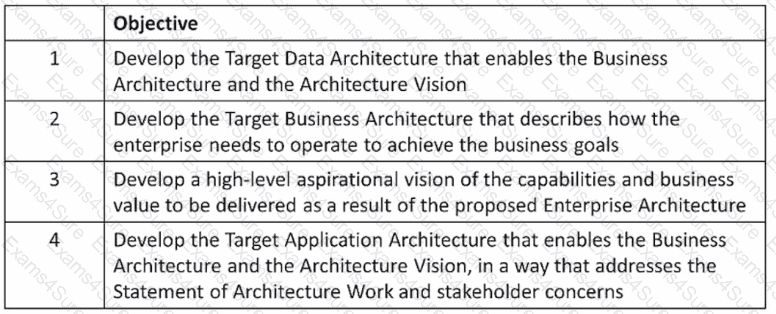TOGAF Enterprise Architecture Combined Part 1 and Part 2 Exam
Last Update 1 day ago
Total Questions : 134
Dive into our fully updated and stable OGEA-103 practice test platform, featuring all the latest Enterprise Architecture exam questions added this week. Our preparation tool is more than just a The Open Group study aid; it's a strategic advantage.
Our Enterprise Architecture practice questions crafted to reflect the domains and difficulty of the actual exam. The detailed rationales explain the 'why' behind each answer, reinforcing key concepts about OGEA-103. Use this test to pinpoint which areas you need to focus your study on.
What provides context for architecture work, by describing the needs and ways of working employed by the enterprise?
Which ADM phase focuses on defining the problem to be solved, identifying the stakeholders, their concerns, and requirements?
Consider the following ADM phases objectives.

Which phase does each objective match?
Which of the following describes the practice by which the enterprise architecture is managed and controlled at an enterprise-wide level?
Which phase of the ADM has the purpose to develop an Enterprise Architecture Capability?
Consider the following statements.
1. All processes, decision-making, and mechanisms used will be established so as to minimize or avoid potential conflicts of interest.
2. More effective strategic decision-making will be made by C-Level executives and business leaders.
3. All actions implemented and their decision support will be available for inspection by authorized organization and provider parties.
4. Digital Transformation and operations will be more effective and efficient.
Which statements highlight the value and necessity for Architecture Governance to be adopted within organizations?
Which of the following best describes a purpose of the Gap Analysis technique?
Complete the following sentence:
Presenting different_________and_________to stakeholders helps architects to extract hidden agendas principles and requirements that could impact the final Target Architecture


TESTED 07 Dec 2025
Hi this is Romona Kearns from Holland and I would like to tell you that I passed my exam with the use of exams4sure dumps. I got same questions in my exam that I prepared from your test engine software. I will recommend your site to all my friends for sure.
Our all material is important and it will be handy for you. If you have short time for exam so, we are sure with the use of it you will pass it easily with good marks. If you will not pass so, you could feel free to claim your refund. We will give 100% money back guarantee if our customers will not satisfy with our products.